Main characters and stories
The stories feature the activities of a small law firm called Jonas Pickett, Solicitor and Commissioner for Oaths, recently started by Pickett, a man "on the wrong side of sixty". [6]
He was not, as he was fond of explaining to his friends, a retired solicitor. He was a retreating solicitor. Having made as much money as a bachelor of modest habits was likely to use in the rest of his lifetime, but not wishing to rust in idleness, he had abandoned a successful practice in north London and set up a modest office in Shackleton-on-Sea. [7]
There are three other main characters, his partner, Sabrina Mountjoy; their secretary, Claire Easterbrook; and a general handyman, Sam Conybeare, "a mountain of a man who had once performed remarkable feats of strength and daring in a circus." Pickett himself had played a role in an earlier Gilbert novel, The Long Journey Home . Confronted by arcane legal matters, Pickett consults Mountjoy: "She's a much better lawyer than I am." [8]
The stories are all told from the third person omniscient narrator perspective, sometimes with the members of Pickett's law firm playing fairly minor roles. They are written with Gilbert's usual straightforward, urbane, and somewhat detached tone but, as is usual in Gilbert's work, there is often a deceptively hard edge or even grimness to some of the stories. In Holy Writ, for instance, a deranged but nevertheless sympathetically portrayed parson is only narrowly prevented by Pickett and Sam Conybeare from killing his trusting young son in emulation of the Biblical story of Abraham and Isaac. In the final story, The Freedom Folk, an encampment of squatters refuses to heed a warning from Pickett and is carried away to the sea by a flash flood; the fairgrounds strongman, Conybeare, heroically manages to save six of them from the waters, but the other 70 are drowned. By the end of the last story, four years have passed since Pickett first opened his office, he has been elected to the local governing council, and he has retired from practice.
In the first story Mr. Calder, one of the two protagonists of Gilbert's Mr. Calder and Mr. Behrens and Game without Rules, makes a brief appearance. In the same story, Pickett also meets a police superintendent named Queen, as well as a headmaster named Major Appleby. Inspector Queen was a character in many of the Ellery Queen mystery novels by Ellery Queen, and Inspector Appleby was the lead character in many novels by Michael Innes.
In the second story, there is a small role for Chief Superintendent Morrisey, head of the London District Regional Crime Squad, a character in a number of works by Gilbert.
Edward Dentinger Hoch was an American writer of detective fiction. Although he wrote several novels, he was primarily known for his vast output of over 950 short stories.
Michael Francis Gilbert was an English solicitor and author of crime fiction.
Mr. Calder and Mr. Behrens are fictional counter-intelligence agents created by the British mystery and thriller writer Michael Gilbert. The characters appear in 24 short stories, most of which first appeared in either the British magazine Argosy or the American Ellery Queen's Mystery Magazine. The stories were collected in two anthologies, Game without Rules (1967) and Mr. Calder & Mr. Behrens (1982). One story, "Double, Double", was later republished in an Ellery Queen paperback. Many involve finding and dealing with British traitors or deeply embedded foreign agents; a few take place in Europe; one particularly grim one is set in World War II, during which Mr. Behrens is the bomb-maker in a failed attempt to assassinate Adolf Hitler. The characters also appeared in 16 BBC radio plays, largely based on the short stories.

Mystery Scene is an American magazine, first published in 1985, that covers the crime and mystery genre with a mix of articles, profiles, criticism, and extensive reviews of books, films, TV, short stories, audiobooks, and reference works.
Bouchercon is an annual convention of creators and devotees of mystery and detective fiction. It is named in honour of writer, reviewer, and editor Anthony Boucher; also the inspiration for the Anthony Awards, which have been issued at the convention since 1986. This page details Bouchercon XXVII and the 11th Anthony Awards ceremony.
Bouchercon is an annual convention of creators and devotees of mystery and detective fiction. It is named in honour of writer, reviewer, and editor Anthony Boucher; also the inspiration for the Anthony Awards, which have been issued at the convention since 1986. This page details Bouchercon XXXII and the 16th Anthony Awards ceremony.

Close Quarters is the first novel by the British mystery writer Michael Gilbert. Published in England by Hodder and Stoughton in 1947, it did not appear in the United States until 1963. By then Gilbert's reputation had been firmly established in both countries and his regular American publisher for many years had been Harper & Brothers. Close Quarters, however, was published by Walker and Company, a less prestigious house. In it we are introduced to Chief Inspector Hazlerigg, who will go on to be a recurring character in a number of Gilbert's works throughout the next ten years. Gilbert, who was appointed CBE in 1980, was a founder-member of the British Crime Writers' Association. The Mystery Writers of America named him a Grand Master in 1988 and in 1990 he was presented Bouchercon's Lifetime Achievement Award.
The Headmaster is a short story by the British mystery and thriller writer Michael Gilbert about the counterspies Mr. Calder and Mr. Behrens. First published in the United Kingdom in the June, 1962, issue of Argosy, it was later published in the United States in Ellery Queen's Mystery Magazine and then collected in book form along with other stories about the same two protagonists as the sixth of eleven stories in Game without Rules. It is set in a contemporary, but undated London, and, unlike most of the other stories in this series, has Mr. Calder as the main character, with only brief appearances by Mr. Behrens and Rasselas, the Persian deerhound. It is written in Gilbert's usual spare style, but with even fewer overtones and descriptions of the characters than are found in most of his works; the plot itself, and its resolution, is also somewhat unlikely, so the story, compared to the others in the series, must be considered a fairly minor one. It does, however, have several examples of Gilbert's understated and astringent humor.
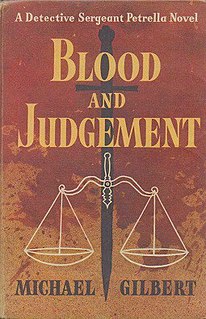
Blood and Judgement is a police procedural novel by the British author Michael Gilbert. Published in England in 1959 as Blood and Judgement by Hodder and Stoughton and in the United States as Blood and Judgment by Harper & Brothers, it was Gilbert's tenth novel. Gilbert, who was appointed CBE in 1980, was a founder-member of the British Crime Writers' Association. The Mystery Writers of America named him a Grand Master in 1988 and in 1990 he was presented Bouchercon's Lifetime Achievement Award.It introduces his most notable series character, Patrick Petrella, as a young and already somewhat controversial Detective Sergeant working out of the fictional Q Division of the Metropolitan Police Area.

Fear to Tread is a mystery–crime thriller by the British mystery writer Michael Gilbert, first published in 1953 by Hodder and Stoughton in England and by Harper & Brothers in the United States. Set mostly in London, it was his seventh novel in six years and built upon the favourable reputation he had achieved earlier with the well-received Smallbone Deceased and Death Has Deep Roots. Gilbert, who was appointed CBE in 1980, was a founder-member of the British Crime Writers' Association. The Mystery Writers of America named him a Grand Master in 1988 and in 1990 he was presented Bouchercon's Lifetime Achievement Award.It is one of numerous stories and novels by Gilbert presenting a gritty, realistic depiction of organized gangs, frequently directed by a deeply concealed mastermind who is not unearthed until the final pages.

Stay of Execution is a collection of mystery stories by the British thriller writer Michael Gilbert, first published in 1971 by Hodder & Stoughton. Gilbert, who was appointed CBE in 1980, was a founder-member of the British Crime Writers' Association. The Mystery Writers of America named him a Grand Master in 1988 and in 1990 he was presented Bouchercon's Lifetime Achievement Award. Unusually for a collection of stories, its reprint edition by House of Stratus in 2011 has no index detailing the stories in the book. The longest story, by far, is the last one in the book, Stay of Execution. At 54 pages, it is what is generally called a novella. Two of the stories feature Chief Superintendent Hazlerigg; three Henry Bohun; and one Detective Inspector Petrella, characters who have figured in other short stories and novels by Gilbert. The Independent said of the book in 2006:
Gilbert had a fondness for amusing but unscrupulous pirates... and an entirely practical, indeed sceptical, view of the workings of the law. It was typical of his humour that the two stories in his excellent collection Stay of Execution (1971) in which rascally solicitors "get away with it", "Back on the Shelf" and "Mr Portway's Practice", were written in the first person.
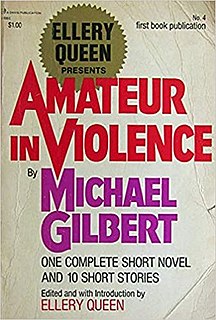
Amateur in Violence is a collection of mystery stories by the prominent British thriller writer Michael Gilbert, published in the United States in 1973 by Davis Publications, a publishing house for magazines, but not in England. Gilbert, who was appointed CBE in 1980, was a founder-member of the British Crime Writers' Association. The Mystery Writers of America named him a Grand Master in 1988 and in 1990 he was presented Bouchercon's Lifetime Achievement Award. The book is edited, and has an introduction, by Ellery Queen, the founder and long-term editor of Ellery Queen's Mystery Magazine. It contains 10 stories and a short novel that had been previously uncollected in the United States. Some of them feature characters who have figured in other novels and short stories by Gilbert. Three stories feature Inspector Hazlerigg and four Inspector Petrella. The short novel, "Stay of Execution", had previously given its name to the title of a collection published in England in 1971.

The Murder of Diana Devon and Other Mysteries is a collection of mystery stories and radio plays by the British thriller writer Michael Gilbert, first published in 2009 by the British company Robert Hale and unpublished in the United States. Gilbert, who was appointed CBE in 1980, was a founder-member of the British Crime Writers' Association. The Mystery Writers of America named him a Grand Master in 1988 and in 1990 he was presented Bouchercon's Lifetime Achievement Award. It contains 13 previously uncollected stories, as well as a poem and two unpublished radio plays featuring his characters Mr. Calder and Mr. Behrens. It has an introduction by John Cooper and an appendix listing all of the Calder and Behrens radio plays. At least two of the stories feature Superintendent Mahood, one of Gilbert's earlier recurring characters and who only appears in short stories.
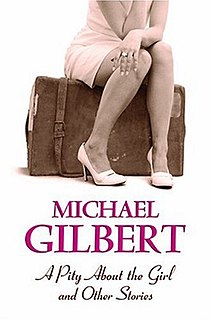
A Pity About the Girl and Other Stories is a collection of mystery stories by the British thriller writer Michael Gilbert, first published in 2008 by the British company Robert Hale and unpublished in the United States. It contains 14 previously uncollected stories, as well as an introduction by John Cooper and two appendices. Some of the stories feature one or another of Gilbert's many recurring characters that he created throughout his long career of writing both novels and short stories. Gilbert, who was appointed CBE in 1980, was a founder-member of the British Crime Writers' Association. The Mystery Writers of America named him a Grand Master in 1988 and in 1990 he was presented Bouchercon's Lifetime Achievement Award. The locales vary from London to Latin America and the time frame from the present back to the Victorian days of Sherlock Holmes. A number of them, such as the title story, "A Pity About the Girl", and the two concerning Colonel Cristobal Ocampas, have an unexpected grimness about them. "Michael was an exceptionally fine storyteller, but he's hard to classify," said one of his British publishers after his death. "He's not a hard-boiled writer in the classic sense, but there is a hard edge to him, a feeling within his work that not all of society is rational, that virtue is not always rewarded.". This is particularly true of the last story in the collection, "By The Pricking of My Thumbs".

The Curious Conspiracy is a collection of mystery stories by the British thriller writer Michael Gilbert, first published in 2002 by the American company Crippen & Landru and then in England. Published to recognize Gilbert's 90th birthday, it contains 20 previously uncollected stories, as well as a brief introduction by Gilbert himself and an appendix for Sources. Gilbert, who was appointed CBE in 1980, was a founder-member of the British Crime Writers' Association. The Mystery Writers of America named him a Grand Master in 1988 and in 1990 he was presented Bouchercon's Lifetime Achievement Award. Four of the stories in this collection feature two of Gilbert's many recurring characters that he created throughout his long career of writing both novels and short stories. Gilbert's introduction says that the topics covered by the stories are "catholic", in the sense of being "of universal human interest; touching the needs, interests or sympathies of all men." The locales vary from London to a Red Sea sheikdom and the time frame from the present day back to the Peninsular War. Some of them, such as "Judith", have an unexpected grimness about them. "Michael was an exceptionally fine storyteller, but he's hard to classify," said one of his British publishers after his death. "He's not a hard-boiled writer in the classic sense, but there is a hard edge to him, a feeling within his work that not all of society is rational, that virtue is not always rewarded.".
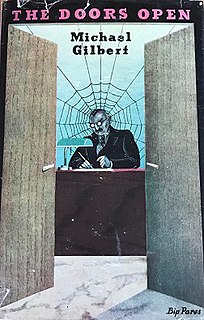
The Doors Open, published by Hodder and Stoughton in England in 1949 and by Walker and Company in the United States in 1962, is the third novel by the British mystery and thriller writer Michael Gilbert. Gilbert, who was appointed CBE in 1980, was a founder-member of the British Crime Writers' Association. The Mystery Writers of America named him a Grand Master in 1988 and in 1990 he was presented Bouchercon's Lifetime Achievement Award. Like his first two books, it features Inspector Hazlerigg, although not in a major role. It is, in fact, a very diffuse book in terms of its characters. Angus McMann, who was the chief protagonist of Gilbert's previous book, They Never Looked Inside, is briefly mentioned on the first page and makes a later appearance as a minor character. Hazlerigg does not appear until page 24 and thereafter only at intervals throughout the book. There are, in actuality, three other protagonists who, along with Hazlerigg, share the role of driving the narrative. One is Noel Anthony Pontarlier Rumbold ("Nap"), a junior solicitor in his father's London firm. Nap had spent four months on dangerous missions with the French maquis in occupied France during the war and is, apparently, still a Lieutenant-Colonel, D.S.O. A few years later he will be a main character in Gilbert's well-received novel Death Has Deep Roots. Patrick (Paddy) Yeatman-Carter, an acquaintance of Nap's, is another lead character, as is his uncle, Alfred Lord Cedarbrook, a man with an astonishing background, much sought after by both the Foreign Office and the War Office during WWII and now, apparently, still affiliated with the Secret Service. As well as being a linguist, explorer, soldier, and diplomat, he also has a law degree. All three of them, to one degree or another, carry out private investigations, sometimes with the backing of Hazlerigg, sometimes not.
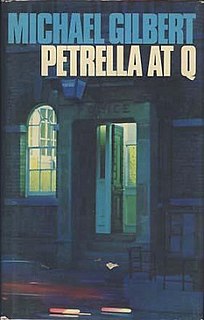
Petrella at Q is a collection of 11 short stories plus one longer story divided into four parts about the British policeman Patrick Petrella by the British writer Michael Gilbert published in the United Kingdom by Hodder and Stoughton in 1977 and in the United States by Harper & Row the same year. Gilbert, who was appointed CBE in 1980, was a founder-member of the British Crime Writers' Association. The Mystery Writers of America named him a Grand Master in 1988 and in 1990 he was presented Bouchercon's Lifetime Achievement Award. Many of the stories had previously appeared in such magazines as Reveille in the United Kingdom and Ellery Queen's Mystery Magazine in the United States. In addition to the stories themselves, there is an introductory sketch of Petrella by Gilbert written especially for this book. A second collection of stories, Young Petrella, was published ten years later, in 1987, but consisted exclusively of stories about Petrella's very first years on the force, when he began as a detective constable.

Even Murderers Take Holidays and Other Mysteries is a collection of mystery stories by the British thriller writer Michael Gilbert, first published in 2007 by the British company Robert Hale and unpublished in the United States. It contains 25 previously uncollected stories, as well as an introduction by John Cooper and an appendix. The first twelve stories feature Inspector Petrella, one of the many recurring characters that Gilbert created throughout his long career of writing both novels and short stories. Its next story has Mr. Calder and Mr. Behrens, and there are four stories about Inspector Hazlerigg. Gilbert, who was appointed CBE in 1980, was a founder-member of the British Crime Writers' Association. The Mystery Writers of America named him a Grand Master in 1988 and in 1990 he was presented Bouchercon's Lifetime Achievement Award. The locales are mostly set in London and its environs. A number of the stories, such as "Somebody" and "Old Mr Martin", have an unexpected grimness about them. "Michael was an exceptionally fine storyteller, but he's hard to classify," said one of his American publishers after his death. "He's not a hard-boiled writer in the classic sense, but there is a hard edge to him, a feeling within his work that not all of society is rational, that virtue is not always rewarded."
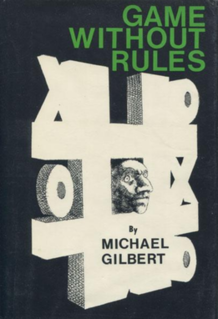
Game Without Rules is a short story collection by the British crime and spy writer Michael Gilbert featuring his counter-intelligence agents Calder and Behrens. The first US edition was published in 1967 by Harper & Row, and the UK edition in 1968 by Hodder & Stoughton. A second collection of stories followed in 1982 under the title Mr. Calder and Mr. Behrens.
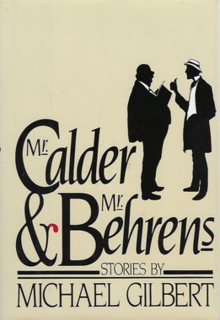
Mr. Calder and Mr. Behrens is a 1982 short story collection by the British crime and spy writer Michael Gilbert featuring his eponymous counter-intelligence agents. It was published by Hodder & Stoughton in the UK and by Harper & Row in the US. The book was Gilbert's second collection of Calder and Behrens stories, following Game Without Rules (1967).














